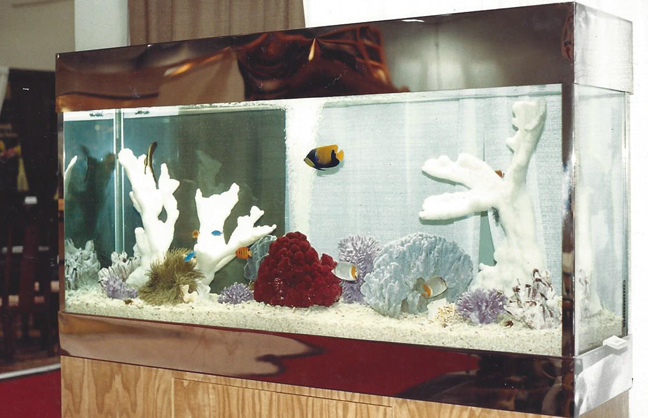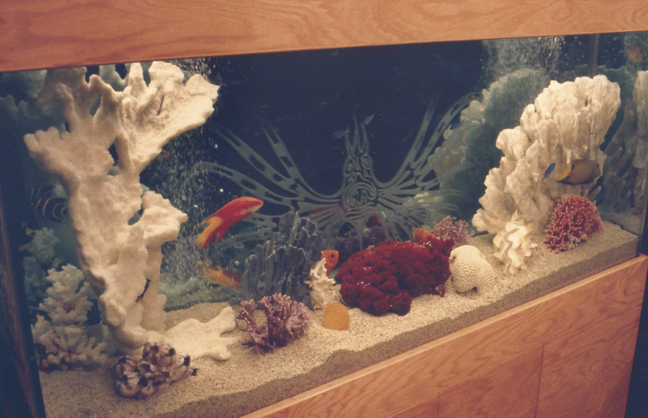Humblefish
Active Member
I setup my first true reef tank sometime in the 1980s, and used all live rock to do it. (We didn't even realize back then that "dry rock" was an option.) Anyway, I put the LR in my tank, and of course there was die-off, but I think it cured in a few weeks. I knew it was safe to add fish/corals once the water completely cleared, and I could see all the little critters emerging from the rocks: Tiny starfish, amphipods, chitons, isopods, nudibranchs, spaghetti worms, bristle worms, stomatella snails, etc. etc. I also knew the rock contained tons of microfauna that I couldn't see, but I did notice tiny bivalves, bryozoan, sponges, cucumbers, feather dusters, hydroids, barnacles, tunicates, etc. growing all over the rocks.
I'm sure I also got some bad hitchhikers in the live rock, but I don't seem to remember those. (I would have definitely remembered a mantis shrimp.) But guess what else I don't remember? HAVING TO GO THROUGH THE UGLIES!!! In fact, the first time I ever saw diatoms & dinos was after setting up a tank using all dry rock. I also never quarantined back in the day, and other than Ich coming & going I never really had any fish disease problems. Hmmmm. Could some of these little critters actually be predators of tomonts and microscopic parasites in general?
I once attended a presentation by Tony Vargas (author of "The Coral Reef Aquarium") where he discussed the "European way" of setting up a tank. He uses all live rock, but sets it out of water (on cardboard) for a few hours so all of the "bad hitchhikers" crawl out. The rock is then placed in the aquarium, but is just left to sit & circulate for 3-4 months before adding any fish or corals. (No lights.) You still have to ghost feed, but the reasoning is that this time allows all the little critters/microfauna living in the rocks to propagate without being eaten by the fish. So when you finally do flip on the lights and start adding livestock, this mass biodiversity takes care of many of the problems (like nuisance algae) we commonly encounter in the first year a tank is setup. The tank is already stable, and you don't get "the uglies" because the tiny animals prevent nutrients from ever building up in the first place. And we all know getting a tank off to a good start is one way to ensure it's long term success. I've never tried this approach myself, but it makes all the sense in the world to me.
So how does a sterile tank with dry rock ever achieve biodiversity? I suppose some gets added every time we add chaeto or a coral frag (but only whatever the coral dip doesn't kill). But it takes YEARS to build up to a meaningful level doing it this way. Using all live rock isn't considered practical/environmentally friendly these days (plus the added cost), so what can you do to add biodiversity to your tank? I can think of a few options:

I'm sure I also got some bad hitchhikers in the live rock, but I don't seem to remember those. (I would have definitely remembered a mantis shrimp.) But guess what else I don't remember? HAVING TO GO THROUGH THE UGLIES!!! In fact, the first time I ever saw diatoms & dinos was after setting up a tank using all dry rock. I also never quarantined back in the day, and other than Ich coming & going I never really had any fish disease problems. Hmmmm. Could some of these little critters actually be predators of tomonts and microscopic parasites in general?
I once attended a presentation by Tony Vargas (author of "The Coral Reef Aquarium") where he discussed the "European way" of setting up a tank. He uses all live rock, but sets it out of water (on cardboard) for a few hours so all of the "bad hitchhikers" crawl out. The rock is then placed in the aquarium, but is just left to sit & circulate for 3-4 months before adding any fish or corals. (No lights.) You still have to ghost feed, but the reasoning is that this time allows all the little critters/microfauna living in the rocks to propagate without being eaten by the fish. So when you finally do flip on the lights and start adding livestock, this mass biodiversity takes care of many of the problems (like nuisance algae) we commonly encounter in the first year a tank is setup. The tank is already stable, and you don't get "the uglies" because the tiny animals prevent nutrients from ever building up in the first place. And we all know getting a tank off to a good start is one way to ensure it's long term success. I've never tried this approach myself, but it makes all the sense in the world to me.
So how does a sterile tank with dry rock ever achieve biodiversity? I suppose some gets added every time we add chaeto or a coral frag (but only whatever the coral dip doesn't kill). But it takes YEARS to build up to a meaningful level doing it this way. Using all live rock isn't considered practical/environmentally friendly these days (plus the added cost), so what can you do to add biodiversity to your tank? I can think of a few options:
- Buy some live rock (or even just 1 piece) to mix in with your dry rock. (I'm not saying to buy from here, but this is what I'm talking about: https://gulfliverock.com/premium-deco-live-rock)
- Buy some mature rock, macroalgae and/or sand from another hobbyist with a healthy, established aquarium.
- Buy a "reef pack" to add diversity (example here) and/or macroalgae (example here) from a trusted source. Basically, look for critters labeled here as good: https://www.lionfishlair.com/hitchhikers-guide/




